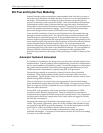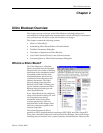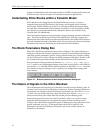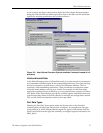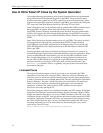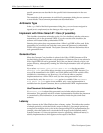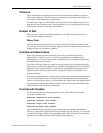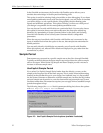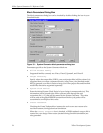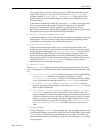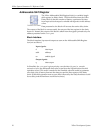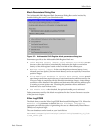
20 Xilinx Development System
Xilinx System Generator v2.1 Reference Guide
specific parameters are described in the specific block documentation in the next
chapter.
The remainder of the parameters in each block’s parameters dialog box are common
to most blocks. These common parameters are described below.
Arithmetic Type
In the Type field of the block parameters dialog box, you can choose unsigned or
signed (two’s complement) as the datatype of the output signal.
Implement with Xilinx Smart-IP Core (if possible)
This checkbox (sometimes referred to as the Use Core checkbox) asks the software to
instantiate a core in the generated VHDL. If you do not select this checkbox, the
software will instead create synthesizable VHDL.
Selecting this option does not guarantee that a Xilinx LogiCORE will be used. If the
parameters for your block are such that a core cannot be generated, synthesizable
VHDL will be generated instead. The System Generator software determines this at
code generation time.
Generate Core
When the Generate Core checkbox is selected, the Xilinx CORE Generator will be
invoked during System Generator code generation. If Generate Core is not selected, a
Xilinx LogiCORE will not be generated, and if the core doesn’t already exist in your
project directory, subsequently running the Xilinx Implementation tools will produce
an error.
If you select Implement with Xilinx Smart-IP Core but do not select
Generate Core, you will be able to simulate your generated VHDL because (1) a
core will be instantiated in the VHDL, and (2) the behavioral VHDL models will be
available for a simulator to use. However, you will not be able to complete
implementation into a Xilinx FPGA until you have also generated the core.
In some blocks, only the Generate Core option is available. If the Implement
with Smart IP-Core option is not available, only a core implementation is
available from the System Generator, but no synthesizable VHDL implementation.
Use Placement Information for Core
If Generate Core is selected,the generated core includes relative placement
information. This generally results in a faster implementation. Because the placement
is constrained by this information, it can sometimes hinder the place and route
software.
Latency
Many elements in the Xilinx Blockset have a latency option. This defines the number
of sample periods by which the block’s output is delayed. One sample period may
correspond to multiple clock cycles in the corresponding FPGA implementation (for
example, when the hardware is overclocked with respect to the Simulink model).
System Generator v2.1 does not perform extensive pipelining; additional latency is
usually implemented as a shift register on the output of the block.





